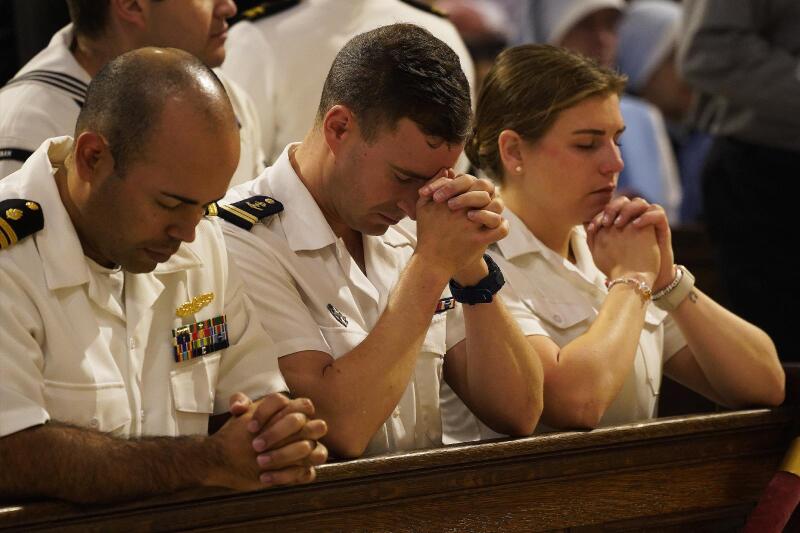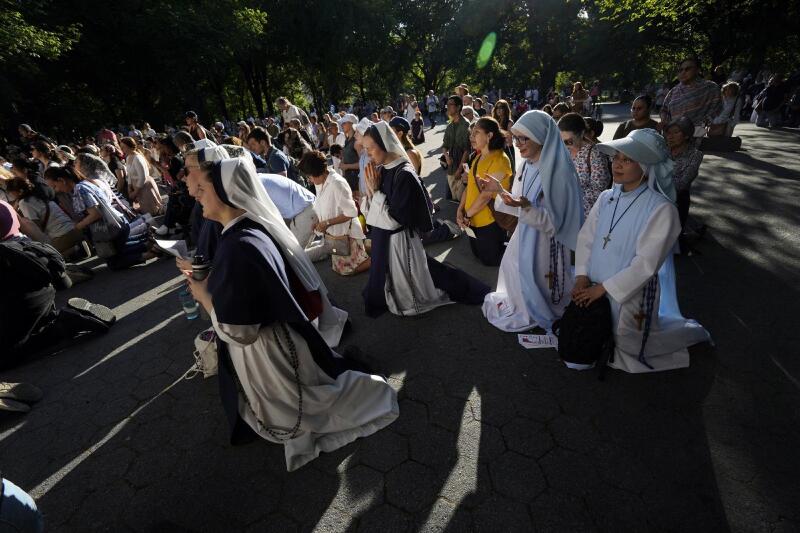
The eclipse, the northern lights, and now: The largest Eucharistic procession in the history of the US to pass through three neighboring dioceses
Anne-Marie Welsh and OSV News
05/27/2024
U.S. Navy personnel pray after receiving Communion during Mass at St. Patrick's 
Cathedral in New York City May 26, 2024, the solemnity of the Most Holy Trinity.
Pilgrims journeying through the Archdiocese of New York on the National Eucharistic
Pilgrimage's Seton Route (East) were among the worshippers attending the liturgy.
OSV News photo/Gregory A. Shemitz
NORTHWEST PA — Hailed as “an unprecedented outpouring of grace,” the National Eucharistic Pilgrimage, involving Eucharistic processions from each corner of the United States that will converge at the National Eucharistic Congress in Indianapolis in July, has begun. More than 100,000 people are expected to participate as the routes wind past iconic sacred and secular sites, offering opportunities for adoration, Mass, accompanying the young ‘perpetual pilgrims’ who are walking the entire length of the route, and of course, walking in procession.
A full overview of the national initiative can be found at https://www.eucharisticpilgrimage.org/, but those residing in the Diocese of Erie will be most interested in learning about the opportunities that will be available as the procession passes through the dioceses of Altoona-Johnstown, Greensburg and Pittsburgh. In addition, a stop in Steubenville, Ohio, may be of interest for those who would like to take part in, or witness the “boater-cade,” as the Eucharist is taken along the Ohio River.
Each of the four routes emanating from a different corner of the country has been named: The Marian Route from the north, the Serra Route from the west, the Juan Diego Route from the south, and the Seton Route from the east, which is the one that will travel nearby the Diocese of Erie.
St. Elizabeth Ann Seton was the first American-born saint to be canonized by the Catholic Church. Raised as a member of a Protestant congregation, as a young mother, she was drawn to the presence of Christ in the Eucharist. Having opened the first free Catholic school for girls in 1810, she is widely credited as the founder of Catholic schools in America.
The Seton Route began in the Diocese of Hartford, Connecticut, on Pentecost Sunday, reaching the Archdiocese of New York on May 22, where pilgrims attended a bilingual Mass celebrated by Auxiliary Bishop Edmund J. Whalen, followed by a Holy Hour that led into all-night adoration. On May 26, they processed from St. Patrick's Cathedral through Central Park for adoration and then across the Brooklyn Bridge for Benediction.
Media are covering the events across the country, sparking conversation and interest among both Catholics and non-Catholics.
“It is such a unique opportunity,” says JoAnn Feeney, of the Diocese of Erie’s Diocesan Eucharistic Adoration Committee. “It is a gift of the Eucharist to us, a pilgrimage with the Lord from all over the country.” She encourages all to participate in even a small portion of the initiative.
“It’s not about the distance,” she says, “but about the disposition of our hearts. It’s about being with Christ and growing closer to him along with your brothers and sisters in Christ.”
In April, Archbishop Timothy P. Broglio, president of the U.S. Conference of Catholic Bishops (USCCB), announced that Pope Francis has granted the opportunity to receive a plenary indulgence for all who participate in either the National Eucharist Congress or the National Eucharistic Pilgrimage/procession.
Bishop Andrew H. Cozzens of Crookston, Minnesota, chair of the board of directors of the National Eucharistic Congress, told Our Sunday Visitor News that the “tradition of giving an indulgence for pilgrimages and important celebrations is ancient.”
“We are grateful to the Holy Father through the Apostolic Penitentiary that offers this blessing to those who are seeking to grow in greater purity of heart through the National Eucharistic Pilgrimage and Congress,” he said. “These events will be great moments of conversion which this indulgence points to as we seek to be free from the effects of our sins.
“Indulgences are a reminder of God’s desire to place his mercy within our reach,” says Father Nicholas Rouch,

Route participate in Eucharistic adoration at Central Park’s Naumburg Bandshell in New York City May 25, 2024.
OSV News photo/Gregory A. Shemitz
vicar general for the Diocese of Erie and pastor of St. Julia Parish, Erie. “”Especially in the seven sacraments, but also in the provision of indulgences, the Lord provides tangible pathways for us to approach him and receive his generosity.” Noting the church provides clear requirements regarding indulgences, Father Rouch says at the heart of any pious act approved by the church for a plenary indulgence are two things: a human soul responding to the grace of conversion and our merciful God who wants us for all eternity.
“An indulgence does not replace the hard work, discipline and obedience required in the Christian life,” Father Rouch says. “But it reassures us that God notices all that we do out of love for him.”
A plenary indulgence can be applied either to oneself or to the souls of the deceased, but they cannot be applied to other persons living on earth, as they have the opportunity to receive one as well. Father Rouch says that seeking a plenary indulgence for deceased loved one “is a great act of charity.”
According to the Compendium of the Catechism of the Catholic Church, “Indulgences are the remission before God of the temporal punishment due to sins whose guilt has already been forgiven. The faithful Christian who is duly disposed gains the indulgence under prescribed conditions for either himself or the departed. Indulgences are granted through the ministry of the Church which, as the dispenser of the grace of redemption, distributes the treasury of the merits of Christ and the Saints.”
The plenary indulgence for National Eucharistic Pilgrimage is granted to anyone who participates in the pilgrimage between May 17 and July 16, as well as to elders, people with infirmities and “all those who cannot leave their homes for a serious reason and who participate in spirit with the National Eucharistic Pilgrimage, uniting their prayers, pains, or inconveniences with Christ and the pilgrimage,” according to the USCCB. To receive the indulgence, an individual must fulfill the usual conditions: sacramental confession, Communion and prayer for the intentions of the Holy Father. (Find Pope Francis’ specific monthly intentions for 2024 at www.usccb.org/prayers/popes-monthly-intentions-2024.)
Click on various stops on the interactive map available at www.eucharisticpilgrimage.org/st-elizabeth-ann-seton-route for the events, times and locations of each opportunity in the dioceses of Altoona-Johnstown, Greensburg and Pittsburgh. It is not necessary to register, although the sites include an opportunity to do so, in an effort to have a sense of the number of people who are participating.
Alternatively, find a listing for the Altoona-Johnstown stops June 9-11 at https://events.blackthorn.io/en/DnDCa1K7/g/seton/seton-route-diocese-of-altoona-johnstown-4a2PDnqpSb/overview
For the Greensburg stops June 11-12 at https://events.blackthorn.io/en/DnDCa1K7/g/seton/seton-route-diocese-of-greensburg-4a2PDnqpSc/overview
For the Pittsburgh stops June 12-19 at https://events.blackthorn.io/en/DnDCa1K7/g/seton/seton-route-diocese-of-pittsburgh-4a2PDnqpSg/overview
Details about the Boater-cade on Sunday, June 23 in the Diocese of Steubenville can be found here: https://events.blackthorn.io/en/DnDCa1K7/g/seton/seton-route-diocese-of-steubenville-4a2PDnqpSq/overview
-
